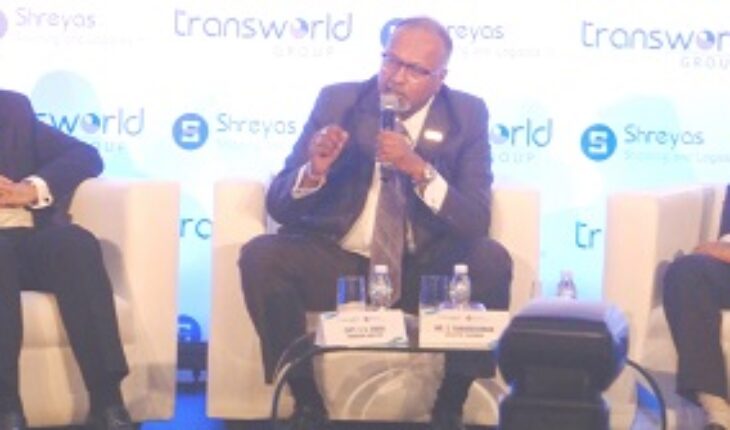Shreyas Shipping & Logistics Ltd (SSLL) highlighted a 45% growth in its standalone annual revenues at Rs 544 crore for FY2018, as against Rs 376 crore during FY2017, EBITDA growth by 123% to Rs 115 crore (FY 18) against Rs 50 crore (FY17), and PAT growth by 2,205% to Rs 81 crore upto March 2018, as against Rs 4 crore in the same period last year, according to Captain V K Singh, Managing Director, (SSLL).
“Total containerized domestic cargo trade on the mainland for 2017-18 increased by 77% to 195,000 containers, as against 110,000 in 2015-16 and this corresponded to carriage and modal shift of cargo from land to sea mode as 5.85 million tons of containerized cargo during 2017-18, as against 3.3 million tonnes two years earlier,” Singh said
SSLL, which is part of the 40-year-old global conglomerate Transworld, is an Indian ship-owning and operating company with prime focus on coastal container shipping and logistic services, he said while describing it as the largest container shipping company in India with a fleet of 13 vessels serving 18 major ports in India while covering the entire Indian coast and other regional areas, and making 1060 port calls in 2017.
Singh said SSLL had acquired 10 vessels including two multipurpose vessels of capacity totaling 242,242 DWT and 18080 TEUS between 2015 and 2017, thus achieving 56% growth while also having 17% CAGR increase in Indian flag container fleet from 2014 to 2017.
“The Indian shipping industry contributes Rs 8,000 crores annually to the Indian economy of which SSLL’s contribution was Rs 470 crore. Growth in Indian seafarers employment in the SSLL’s fleet was 55% from 2015 to 2017, and Indian shipping companies like us are also training them, besides giving them employment, as our contribution to the Indian economy,” he said.
Describing as a “far-fetched myth” that relaxation of cabotage law for EXIM containers would lead to foreign transshipment shifting to Indian terminals, Singh said the problem was not cabotage restriction but many other challenges like infrastructure and capacity constraints, high port costs, documentation procedures and largely depending on the network planning of the shipping lines.
“Based on this myth, the Ministry of Shipping issued a General order No. 1 of 2018 dated May 21, 2018, which does not require a foreign flag container vessel to obtain a licence under section 407 of the MSA to carry EXIM containers and empty containers on the coast. The essence of this order is that there is no necessity to have an Indian flag vessel for the purposes of carriage of EXIM and empty containers between two Indian ports. While the outcome of this circular, as envisaged by MOS, will be seen in course of time, this may have setbacks for the Indian coastal shipping with respect to carriage of Exim transshipment containers.”
“In the absence of a level playing field, even Indian companies may consider flagging vessels outside India and operating on foreign trade, resulting in our nation losing the opportunity of developing a ‘Transshipment Hub’ port as well as growth in India tonnage, which are important aspects for our nation,” Singh said while noting that SSLL’s mantra of growth focused on seeking better opportunities to enhance 20% growth in tonnage y-o-y for both container and break bulk in dealing with growth potential in cargo volume, besides its own tonnage replacement plan.
Replying to questions, Ramesh S. Ramakrishnan, Executive Chairman, SSLL, said “The biggest problem we face is that in advanced countries like USA, Europe, business is kept under their own flags. We are seriously contemplating taking advantage of minimized costs as there is huge domestic business for us, and are thinking of even flagging some of our ships in areas that are business-friendly – including China which is having tremendous amount of business coming into India – though we are not going in for expansion. Also, Sri Lanka is in the forefront of development and also on the main trunk route so that shipping lines cannot ignore what Colombo has to offer.”
“Shipping lines are shrinking and the number of big lines are coming down. But Sri Lanka will continue to be a “cog-in-the-wheel” where East-West shipping business is concerned. Cabotage will not bring in business or disturb the business we have and there are other things that Operators and Government will have to grapple with to continue inflow. Coastal shipping is still in the infant stage and today trade is still miniscule, where even the USA does 8% to 10% more business in comparison to India barely doing 5% to 7% in a scenario where the Government envisions 18% to 20% increase due to huge growth opportunities,” Ramakrishnan said, adding “The strategy is in expanding our markets, using our capacity in a more optimal way and operating our vessels along the coast by deploying them successfully.”






